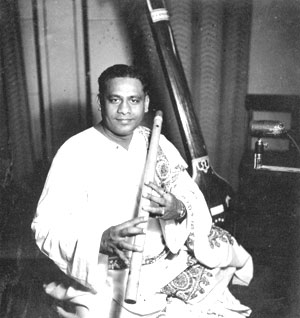
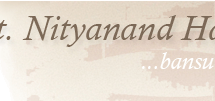
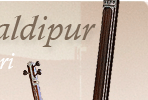
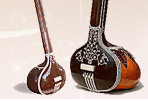


|
|

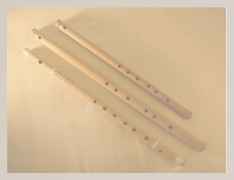

Pt. Pannalal ghosh
Born in Barisal, East Bengal (now Bangladesh) on July 31, 1911, Amulya Jyoti (nicknamed Pannalal) Ghosh was a child prodigy. He inherited his love of music and the bamboo flute (bansuri) from his grandfather, Hari Kumar Ghosh who played sitar,tabla,and pakhawaj and learned sitar from his father, Akshay Kumar Ghosh. He also learned music from his maternal uncle, Bhavaranjan Mazumdar who was a vocalist. The family first lived in the village of Amarnathganj and later moved to the town of Fatehpur.
Two apocryphal incidents happened to young Pannalal which had an influential bearing on his later life. First, at age 9 while looking for a stick, Pannalal found a flute floating in the river. He retrieved the instrument and so began his lifelong relationship with the bansuri. Two years later at age 11 Pannalal met a sadhu who held both a conch and a flute. The sadhu asked Pannalal if he could play the flute, and young Pannalal obliged. The sadhu gave him the flute and told the boy that music would be his salvation.
There was a political unrest in 1928, and every youth was possessed with the freedom movement. Pannalal also joined this freedom movement. He enrolled in a gymnasium where he learned martial arts, boxing, and stick fighting and practiced physical culture. Pannalal was very fond of physical culture. He became the best student and champion of this gymnasium. He became more involved in the freedom movement and the British Government started keeping a watch on his movements. So at the age of seventeen Pannalal left Barisal and went to Calcutta in search of livelihood. In the teeming metropolis he found himself without any credentials except that he was a boxing champion and had won the All Bengal competition in boxing. With his skill as a boxer and martial art expert he landed a job as a coach in an athletic club. One year later, at the age of 18, Pannnalal lost his father.
At this time Pannalal, who was already playing sitar, began to focus his attention on bansuri. Economic necessity drove him into performing music for the silent films in Calcutta. At an All India music competition he met music director and composer Anil Biswas and began to play in his musical productions. It was during one such production when Anil Biswas was directing music for a dramatization of a work by the renowned poet Kazi Nazrul Islam that Pannalal decided that he needed a bigger flute who's pitch and sonority would be more appropriate for both classical and light music. He met an old Muslim toy vendor who was also proficient in making flutes. With his help Pannalal experimented with various materials including metal and other types of wood, but decided bamboo was still the most suitable medium for a larger instrument. He finally settled on a bansuri which was thirty two inches long, with a sa (tonic) at kali doe (the second black key on the old harmonium scale). As a flute of this size was hitherto unknown, a rumor arose that Pannalal had had surgery to cut the webbing between his fingers to facilitate the large span required to cover the finger holes of the instrument. Of course, he had no such surgery, but through dedicated riyaz (practice), Pannalal invented and perfected the technique to play the large instrument. At this time he would get his bamboo to make flutes from discarded packing materials found at Diamond Harbor, the large port of Calcutta. Deforestation had not yet consumed the forest around Calcutta, and the bamboo was believed to have grown close to the city itself. He practiced hard and perfected the technique of vocal music on flute. At this time he realized the need for meend from madhyama swar to nishad or dhaivat shrutis in ragas like Bihag, Yaman, Bageshree and many others. He experimented and invented the seventh hole of madhyama.
He became famous for his flute playing and started getting performances at the major music conferences. At this time he came in close contact with great maestros like Ustad Inayat Khan (sitar), Ustad Dabir Khan (Been), Ustad Amir Khan (sarod), Ustad Badal khan (sarangi), and vocalists such as Ustad Faiyaz Khan, Ustad Abdul Karim Khan, Ustad Majid Khan, Pt. Tarapoda Chkraborty, Pt. Bhismadev Chattopadhyay and many others. His quest for knowledge and purity of tradition made him acquire intricacies of music from these erudite musicians.
In 1936 Pannalal began working with Raichandra Boral, music director of the well known 'New Theater' and one year later he met his first guru, Kushi Mohammed Khan - the 'Harmonium Wizard'. In 1938 as music director of the dance troupe of the princely kingdom of Seraikella State, Panna Babu (as he was affectionately known) was one of the first classical musicians to visit and perform in Europe, which he found rather agitating and unsettling. Soon after his return to India his guru expired. Thereafter he underwent training from Girija Shankar Chakravarti. In 1940, Pannalal moved to Bombay on the advice of his first disciple Haripada Choudhary (who had himself recently moved to Bombay). There he joined the Bombay Talkies film studio and gave music to quite a few films including 'Basant.' Panna Babu's wife, Parul Biswas, (sister of Anil Biswas), was a graceful singer of kirtans who became one of the first well known playback singers for the new 'talking' films.
Pannalal first met the legendary Ustad Allaudin Khansahib, (reverentialy known as 'Baba') in 1946, when Baba came to Bombay with his disciple, Pandit Ravi Shankar. Initially, when Pannalal asked Baba to teach him Khansaheb replied, "You are already great, you don't need to study more." Pannalal implored Baba to please teach him so that he could learn "authentic music and sur." In 1947, Pannalal's lifelong yearning to learn music from a true guru was fulfilled when Allaudin Khansaheb , convinced of Pannalal's sincerity to learn, accepted Pannalal as his disciple. Pannalal then accompanied Baba to his home in Maihar, where he received intensive taalim (training) from Khansaheb for the next six months. Under Baba's firm yet understanding tutelage, he blossomed into the wizard of the bamboo reed.
Panna Babu earned fame through his regular broadcasts on AIR (All India Radio) and his many live performances at music festivals throughout India. The eminent vocalists Ustad Fayaz Khan and Pandit Omkarnath Thakur appreciated his music very much and requested Pannalal to accompany their vocal recitals on bansuri. He was praised for his adaptation and rendering on the bansuri of the khayal-ang- gayaki (the classical vocal style), particularly influenced by the great master of the Kirana gharana, Ustad Abdul Karim Khan. Pannalal also incorporated alap, dhrupad-ang-gayaki, tantrakari, jhala, thumri, dadra and folk music into his performance style on bansuri. Well versed in tabla and rhythm, he would perform in such difficult tals as jhoomra and tilwara. His music was steeped in devotion and had an intangible ethereal element, immense emotional depth and was infused with spiritual profundity. In addition to introducing the larger instrument, Pannalal Ghosh is credited with inventing the bass bansuri and introducing the six-stringed tanpura, high-pitched tanpuri and the surpeti or sruti box into Hindustani music. He created and popularized several new ragas including Deepawali, Pushpachandrika, Hansanarayani, Chandramauli, Panchavati and Nupurdwani, as well as multitudinous vilambit and drut compositions in many well known ragas.
Panna Babu practiced daily meditation and observed maun by not speaking on Thursdays. He took the vows of Ramakrishna and put his faith in music. He took Mantra Diksha from Swami Birjanandji Maharaj who was a direct disciple of Swami Vivekananda. Because of his intense spiritual practice he started loosing interest in day to day life and decided to take Sanyasa. When he expressed his desire to Swamiji, his Guru, he was told that he would attain Moksha through music only. He should practice music as religiously as his spiritual practice. His music showed total spirituality, simplicity and purity.Pannalal continued composing and recording music for films, but began to find film work distasteful. Panna Babu's impressive rendition of Raga Darbari Kannada in his 1956 National Programme broadcast from AIR Delhi fetched him further acclaim and at this time B.B Keskar, director of AIR, awarded him the meritorious post of composer-conductor of the Indian National Orchestra and producer for AIR Delhi. He held the post and maintained his devotion to the interpretation of classical music on the bamboo flute until his untimely and sudden death due to heart attack at the age of 49 on April 20, 1960 in New Delhi.
He left his musical legacy in the capable hands of his principal disciples:
the late Haripada Choudary, Devendra Murdeshwar, V.G. Karnad and Nityanand Haldipur .Listen to Pandit Pannalal Ghosh: 28.8 realaudio stream
Raga Shree: vilambit (slow) Tilwara Tal (16 beats) and fast Teen Tal (16 beats)
This is the entire original HMV Recording - 19 minutes. It was the first LP recording of bansuri, with Rag Yaman on the A side.
HOME | REVIEWS | CDs| INTERVIEWS | DISCOGRAPHY | BANSURI | CONTACT ME
